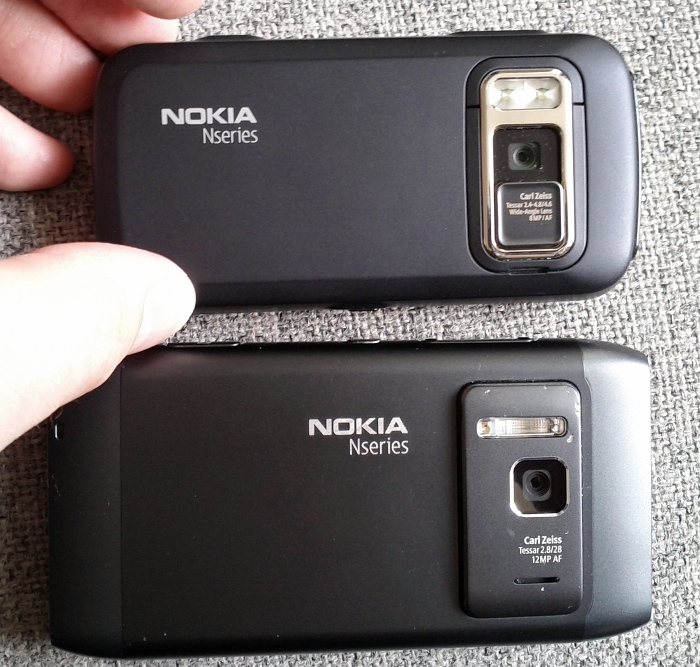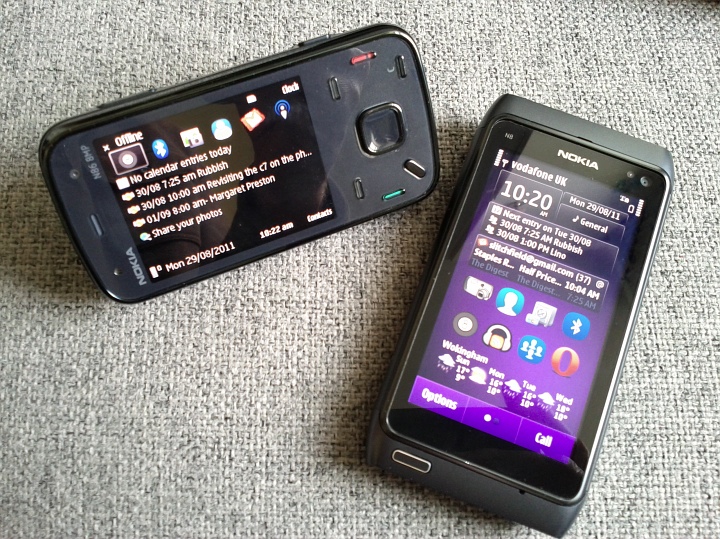
Although we're talking about devices from different eras, we're also talking about totally different visions for what a 'smartphone' is. The N86 (and the N95 etc) were conceived as being in traditional 'phone' form factor, but with massive amounts of 'converged' functionality, i.e. 'smartphone' according to Nokia's, Symbian's and (ahem) my definition. At least, our definition pre-2009. The N86, as previously eulogised, represents perhaps the pinnacle of that form factor and function set - and still holds its own in my eyes today.
Outside the Symbian world though, definitions and expectations were changing. The word 'smartphone' has been hijacked to concentrate on smart software more than smart hardware, with a focus on Internet-connected applications in particular. There's nothing wrong with this change in meaning in itself, but it does make it rather confusing for users and readers of tech sites. The N8 sits, with the other Symbian^3/Anna phones, in an awkward place, having most of the focus of their preceding S60 phones but with a slice of 2010/2011 smartphone and social connectivity thrown in, in a fashion that's sometimes less than elegant.
But how do the two generations of Symbian compare? I keep getting tempted back to the more authentic (in terms of the one-handed S60 UI) older phones, and with the camera specialism of these two devices, it seemed a good head to head to attempt.
| Nokia N8 | Nokia N86 | |
| Year announced | 2010 | 2009 |
| Latest firmware | Symbian Anna, v22 (PR 2.0), effectively three generations of Symbian on from the N86's... | S60 3rd Edition, FP2, v30 |
| Form factor, materials, durability | Aluminium shell, plastic end caps, full-face Gorilla Glass capacitive touchscreen, 135g | Metal chassis, rim/side buttons, and slide mechanism, plastic keypad, other case components and back cover, tempered (toughened) glass screen and command button face, 149g (surprisingly heavy - it's all that metal inside?) |
| Dimensions | 113.5 x 59.1 x 12.9 mm | 103.4 x 51.4 x 16.5 mm (closed) |
| Connectivity | Pentaband 3G, Wi-Fi b/g/n, Bluetooth 3.0, 'USB on the go' (to USB disks/accessories) | Dual band 3G (according to market), Wi-Fi b/g, Bluetooth 2.0, Universal Plug'n'Play |
| Input mechanisms | Virtual qwerty portrait and landscape keyboards with writing aids, plus optional numeric 'T9' input in portrait mode. Compatible with most Bluetooth and USB keyboards | T9 keypad input with spelling prediction. Compatible with most Bluetooth and USB keyboards. |
| Display | 3.5" (360 x 640 pixels) AMOLED with anti-reflection layer, gorgeous indoors, just about readable in bright sunlight | 2.6" (240 x 320 pixels) AMOLED, gorgeous indoors (if smallish) but very hard to read outdoors in bright sunlight |
| Interface | Symbian Anna, kinetic scrolling everywhere, multi-touch where needed, three homescreens of live widgets, whole interface works in portrait or landscape mode. | S60 3rd Edition FP2, one-handed d-pad driven, non-touch interface. Active standby screen with Calendar, email, music and other information plug-ins. Whole interface works in portrait or landscape mode, but text entry is only possible in portrait (obviously). |
| Speed | Good, with 110MB (ish) free RAM for great multitasking, and a Broadcom graphics processor to help out with effects, transitions and multimedia. Video playback is terrific, with a wide range of codecs supported. |
Largely good, though all driven from a 434MHz processor. 80MB free RAM after booting. S60 3rd Edition FP2 is very mature now and the N86 rarely slips up in the speed stakes. Multitasking means that you can run up to 20 or so S60 applications at once and switch between them quickly. Video playback is as good as it ever got on S60 3rd/5th Edition, but it pales compared to the codecs and compatibility introduced in Symbian^3. |
| Memory capacity (storage) | 250MB of (C:) system disk, plus 16GB mass memory and microSD expansion. Apps can be installed on any disk. Plugging in the phone to any desktop computer allows mass memory and microSD to be mounted and treated like any other disk. | 78MB of (C:) system disk, plus 8GB mass memory and microSD expansion. Apps can be installed on any disk. Plugging in the phone to any desktop computer allows mass memory and microSD to be mounted and treated like any other disk. |
| Camera (stills) | Superlative 12 megapixel stills, taken very quickly, with huge sensor and professional optics. Exposed camera glass, so important to check and/or wipe it before important shots. Super Xenon flash and tuned camera hardware make for foolproof evening/social shots. Shutter button is beautifully balanced. | Excellent 8 megapixel stills, with large sensor and professional optics. Importantly, the camera glass isn't exposed - sliding the camera cover open also starts the Camera application. Variable aperture optics make for good results in most light conditions, though dual LED flash can't compete with the N8's Xenon and flash-lit shots will show blurring where the subject moves. Stiff camera shutter button takes some getting used to. |
| Camera (video) | HD (1280 by 720) video is superb (with camera glass cleanliness caveats), fixed focus with very large depth of field, from 50cm to infinity, plus optional 'Close-up' mode with continuous auto-focus. Intelligent (non-lossy) 3x digital zoom; audio capture in stereo and with pro-quality digital mikes. | Also superbly crisp video capture with high depth of field, from 50cm to infinity, but limited to VGA (640 by 480) resolution by the sensor technology of the day. Also has intelligent (non-lossy) 3x digital zoom. Again, the protected camera glass helps make sure clips aren't spoilt by dirt or dust. Audio capture is in mono but is captured with a pro-quality digital mike. |
| GPS and navigation | Good GPS, backed up by Nokia Wi-fi location, with Ovi Maps 3.6 worldwide free sat-nav and many POI extras. Maps can be pre-loaded by continent, country or area. Includes digital compass. | Good GPS, backed up by Nokia Wi-fi location, with Ovi Maps 3.4 worldwide free sat-nav. Maps can be pre-loaded by continent, country or area. Includes digital compass. |
| Audio out | Loud mono speaker, 3.5mm jack, A2DP, FM transmitter to car radio, plus Dolby Digital Surround Sound (through HDMI port) | Loud (but tinny) stereo speakers, 3.5mm jack, A2DP, FM transmitter to car radio. Music (and podcast playback) control via dedicated buttons on the top part of the 'dual slide'. |
| Web browsing | Symbian Web (webkit-based), functional without ever really impressing, though there is Flash support (including video) if needed and multi-touch | Symbian Web (webkit-based), functional but slow and limited by QVGA screen resolution. There is Flash support (including video) if needed, but most users will want to use Opera Mini instead, which offers greater speed and flexibility |
| All purpose Mail client provides 'push' facilities for Mail for Exchange, Hotmail, Gmail, Yahoo! mail and many others - works well on the whole now, under Symbian Anna | Nokia Messaging provides 'push' facilities for Mail for Exchange, Hotmail, Gmail, Yahoo! mail and many others - it works but is slow and often clunky on S60 3rd Edition | |
| Other application highlights out of the box | Quickoffice editors, Dictionary, Zip manager, Photo editor, Video editor, Nokia Social Networking | Quickoffice viewers, Dictionary, Zip manager, Nokia Podcasting, Nokia Internet Radio, Share online |
| Application store and ecosystem | Ovi Store client v2.0, thousands of native Symbian and Qt applications are compatible. There's now an official automatic update system, though many apps also go online and check for themselves if updates exist | First generation Ovi Store client, thousands of native Symbian and Java applications are compatible. There's no automatic update system though, apps are expected to go online and check for themselves if updates exist |
| Battery | 1200mAh, not strictly user replaceable (though it's not that hard, can be done in under 1 minute), microUSB or 2mm charging, nightly charging needed for power users | 1200mAh, BL-5K battery can be easily swapped, microUSB charging, nightly charging needed for power users |
| Ongoing firmware support and OS updates | Prospects good, Nokia has already committed to Symbian Belle update, most experts estimate support and upgrades will continue for up to another year (at least). Many OS modules and components can be upgraded as-and-when using the 'Sw_update tool' in the device | Firmware updates have now stopped, though occasional application updates via Sw_Update shouldn't be ruled out |


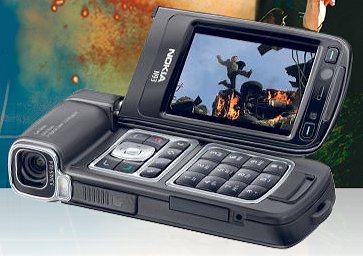
Looking back, it's easy to see a direct lineage of camera-specialist smartphones in Nokia's portfolio. From N73 to N90 to N93 to N95 to N82 to N86 to N8, we see a stunning (for their time) range of phones that dominated the competition of their time in terms of camera and video quality. Most of this is down to Damian Dinning and his team, plus those involved in the Carl Zeiss partnership.

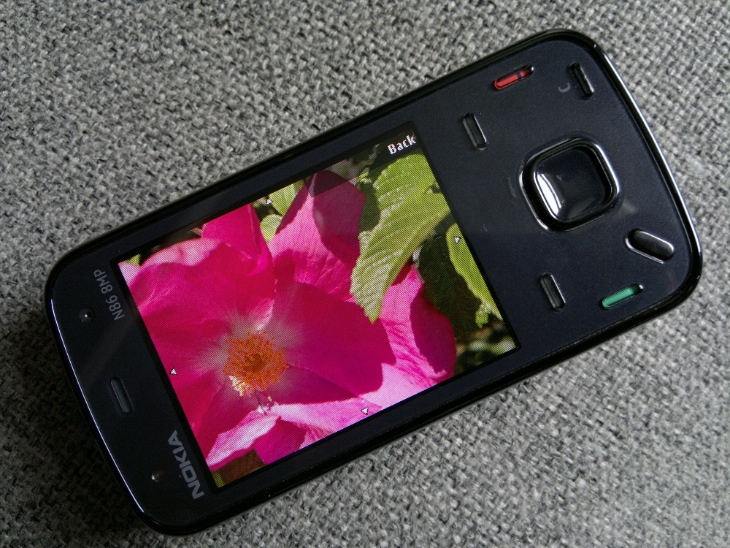
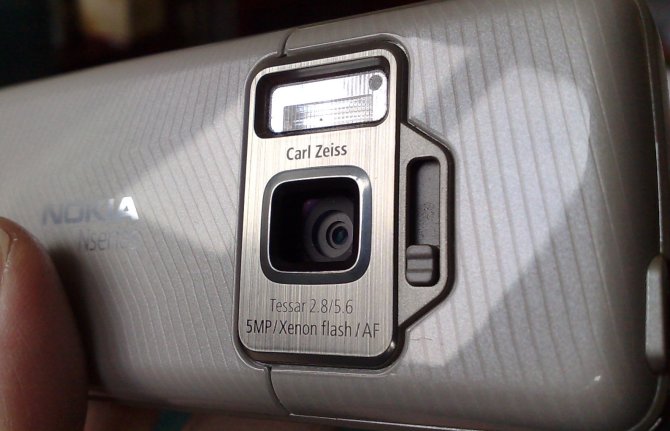
The N86 and N8, as the two most recent in this line-up, are also the two offering best quality stills and video and it was fun putting the above table together, though it wouldn't have been appropriate to use my usual 'shaded cells indicating a winner' system because of the relative ages/generations of hardware and software. Though the N86 was launched in 2009, its heart and soul lie in 2008 or earlier, with designs like the N95 8GB and N82 - and with the recent OS update for the N8 to Symbian Anna, we've arguably got a three year gap between the two phones.
Which is not to say that the N86 doesn't score heavily over the N8 in a few areas. The covered camera glass is the big one - the easily replaceable battery is another core benefit. Plus I'd highlight the multimedia controls and the tactility of physical call/end/text entry buttons as well. But the N8, of course, simply out-guns the N86 at the end of the day, as indeed it should.
Looking back on the camera smartphone line-up above, my only regret is that I owned them all at one point and rather regret selling the older models, some of which have now become collector's items!
Comments welcome if you're tempted to go 'retro' too - is it just me? And do you agree with my 'outgunned' conclusion?
Steve Litchfield, All About Symbian, 30th August 2011
